Trail running is an activity that requires planning. Just like the selection of shoes and clothing for training and races, choosing the ideal backpack is a personal decision, but it must meet some fundamental characteristics.
Factors such as locations, distances, weather, and temperature determine the choice of trail running backpack size, which should accommodate the necessary gear and hydration system to ensure comfort and safety.
We spoke with athletes to help you choose the ideal backpack model, as well as to present innovations in the outdoor market and offer other tips to help you perform well in trail races.
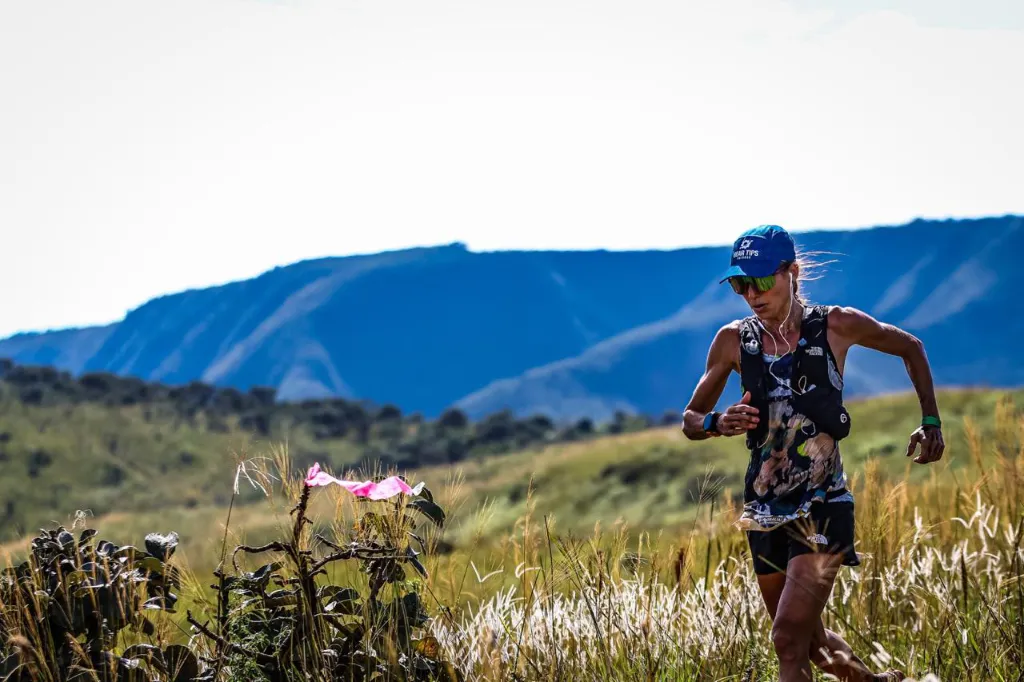
The North Face Vest 8 in use during the Summit Race Day – Rosália Camargo
Characteristics of Trail Running Races That Impact Backpack Choice
Race Distance and Required Gear
Spending hours running on trails requires careful planning regarding food and hydration. Therefore, it is recommended to choose a backpack with enough space to carry water, as well as pockets for gels and other essential items.
It is common for many long-distance trail running races to require a longer list of mandatory gear, which may include headlamps and even emergency blankets, making it crucial to choose a backpack with compartments to carry them.
Weather, Temperature, and Biome
Weather conditions and the location where you will be running during a trail running race significantly impact the choice of backpack, especially regarding size and the hydration system. For example, if you’re running in the mountains during winter, you’ll need to bring extra cold-weather clothing to stay warm, which will require a larger backpack.
You won’t necessarily use all your clothing during the race, but it is crucial during rest periods or in case of any emergencies. Being unprepared in such situations can lead to complications like hypothermia.
If the race takes place in a drier and more arid location, with limited water availability, it’s essential to pay attention to the space reserved for the hydration system—whether it’s bottles or reservoirs—to ensure comfort and safety over long periods.
How to Choose the Right Backpack Size for Trail Running
Choosing the ideal size for trail running backpacks involves two aspects: the recommended volume for carrying gear, hydration and food systems, and your body type to ensure more comfort and performance during training and competitions.
1. Backpack Choice by Volume
The characteristics of the trail running race you will participate in will determine the size and model, which can range from vests to backpacks with capacities between 2 and 20 liters. To choose the ideal model, you should consider the time you will spend on the trail, the mandatory gear, the amount of hydration needed, and the availability of water along the route. If the race has many aid stations, you may be able to refill bottles and reservoirs frequently.
In shorter races, such as the short (8 km) category of the WTR Serra do Mar, for example, it is recommended to carry a hydration system with 500 ml of water. Therefore, in this case, you can opt for a waist pack or a smaller backpack. In the Ultra (56 km), however, it is mandatory to carry a 1.5-liter hydration system, along with gear such as a headlamp and emergency blanket, which will require a backpack with more volume.
“The greater the mandatory gear, the larger the backpack size. In races like the Patagonia Run, in Argentina, for example, you must carry more equipment depending on the weather, like pants”, explains Pedro Lacaz Amaral, founder of Gear Tips.
This is one of the criteria used by athlete Rosália Camargo when choosing the right backpack. “In 100-mile races like the HOKA Kodiak, from UTMB, in the United States, the mandatory items are only the mobile phone and a 500 ml water bottle, which allows me to use a vest. In contrast, if you do the UTMB in Paraty, you’ll need to carry pants, a waterproof jacket, and a base layer, for example. Therefore, the backpack needs more volume.”
Choosing the right size backpack according to the type of race is also a point of attention highlighted by athlete and coach André Medeiros to avoid surprises. “I have participated in races with backpacks too large for carrying a few items, and it was a very uncomfortable experience. It bounced a lot on my back.”
How Hydration Systems Influence Backpack Volume Choice
Most brands offer front pockets to accommodate soft flasks (flexible bottles) and space for including a hydration reservoir on the back. The criteria for choosing a backpack are personal, but it’s essential to assess how much water you will need, considering the race rules. For example, if you’re required to carry 2 liters, you may need a back reservoir, as soft flasks usually hold 500 ml each.
CamelBak, a well-known brand for its hydration backpacks, offers models that come with soft flasks and others with reservoirs. “The choice depends on each person’s strategy and where they will run. For example, I sweat a lot, and for some races, I carry a back reservoir with water and sports drinks in the bottles to stay hydrated throughout the race,” explains Pedro.
According to him, it’s important to remember that when choosing to carry the reservoir on your back, the internal volume of the backpack will be reduced. In that case, he recommends the Deuter Ascender 13, which has a larger internal space, allowing you to organize the liquid volume. “It was the ideal choice for the challenging El Cruce race, a 100 km race divided into three days in the mountains of Patagonia, Argentina. With this backpack, it’s possible to carry up to 3 liters of liquid.”
In this video, Pedro reviews the Deuter Ascender 7 and 13 backpacks:
2. Evaluating Your Body Type
When looking for a backpack that fits your physical characteristics, you will find some products on the market that offer unisex models with compression straps for adjustment, others divided by gender, or models available in sizes such as S, M, L, and even XL, which may vary between female and male versions.
One of the models used by Rosália Camargo is the The North Face Summit Run Race Day 8 Backpack. “Since I’m very small, I always choose the smallest size. A very large backpack can bounce on the body, while a small model can be too tight and hinder the race. This is very important. The North Face models, for example, range from size S to XL.”
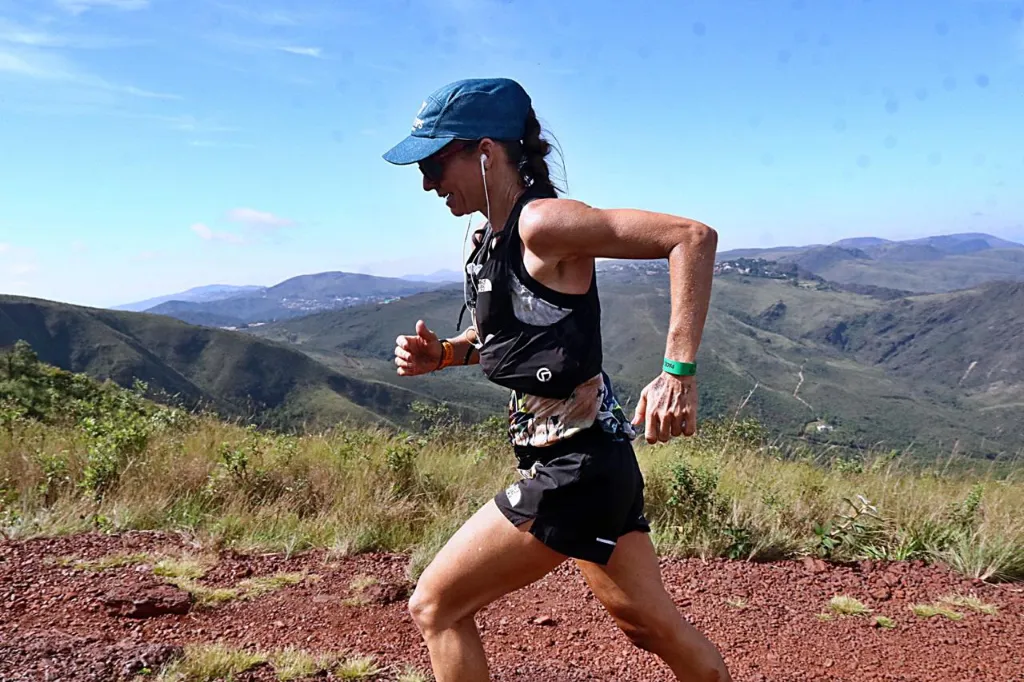
The North Face Vest 8 in use during Summit Race Day – Rosália Camargo
An important tip from André Medeiros is to check if, when closing the backpack, the left strap doesn’t get too close to the right one, which can cause discomfort, especially due to the weight to be carried. The ideal, according to the coach and athlete, is to leave a gap of about four to five fingers between them.
“Even maintaining this distance, you’ll notice that in the middle of a medium-distance race, between 20 and 30 km, the backpack will already be more adjusted to the body because we lose liquid during the run. At the beginning, our body has 100% of the water reserve, but especially in summer, we lose a lot of liquid. In the end, this gap may be reduced to only two fingers. So, don’t choose a backpack that’s too tight,” explains André.
Comfort and Practicality: Essential Items for Choosing a Trail Running Backpack
Factors such as the number of pockets, the lightweight design of the backpack, straps, and bungee cords are also essential for those looking for comfort, practicality, and performance in trail running races. Check out some recommendations from athletes:
The More Pockets, it’s better
One of the determining factors that led Rosália Camargo to invest in a trail running backpack is the practicality offered by the number of pockets. “In addition to the space for holding two bottles in the front, it’s essential that the backpack have front pockets that are easy to access. When you’re running, stopping to grab something from the back, like a gel or salt capsules, is quite complicated. The more pockets, the better, as you can organize your food more practically,” she explains.
Both Rosália and André Medeiros point to the deuter Traick 9 as a model that exceeds expectations when choosing a trail running backpack. It features twelve well-distributed and easily accessible pockets. “There’s a very large side pocket, in addition to a wrap-around pocket at the lower back, which spans the entire width of the backpack. This pocket is great for storing items like a headlamp,” highlights André.
The athlete also recommends the Apex Pro Vest CamelBak, a backpack with nine easy-to-access pockets for food, water, and other essentials, as well as a secure zippered pocket for a phone.
For ultramarathoner Alexandre Gonçalves, those aiming for performance know that every second counts. Therefore, the pockets of a backpack should provide quick and easy access to facilitate nutrition during races.
The athlete uses the Kailash Fast 10L Backpack Vest, which he recommends both for long races, which require more gear, and for shorter races, due to its compact size. In total, it has 10 pockets. “In the back, there’s an elastic pocket with a large space, perfect for carrying a larger amount of equipment. There’s another pocket on top, as well as on the sides. Since they are made from elastic material, you can fit a lot in them,” explains Alexandre.
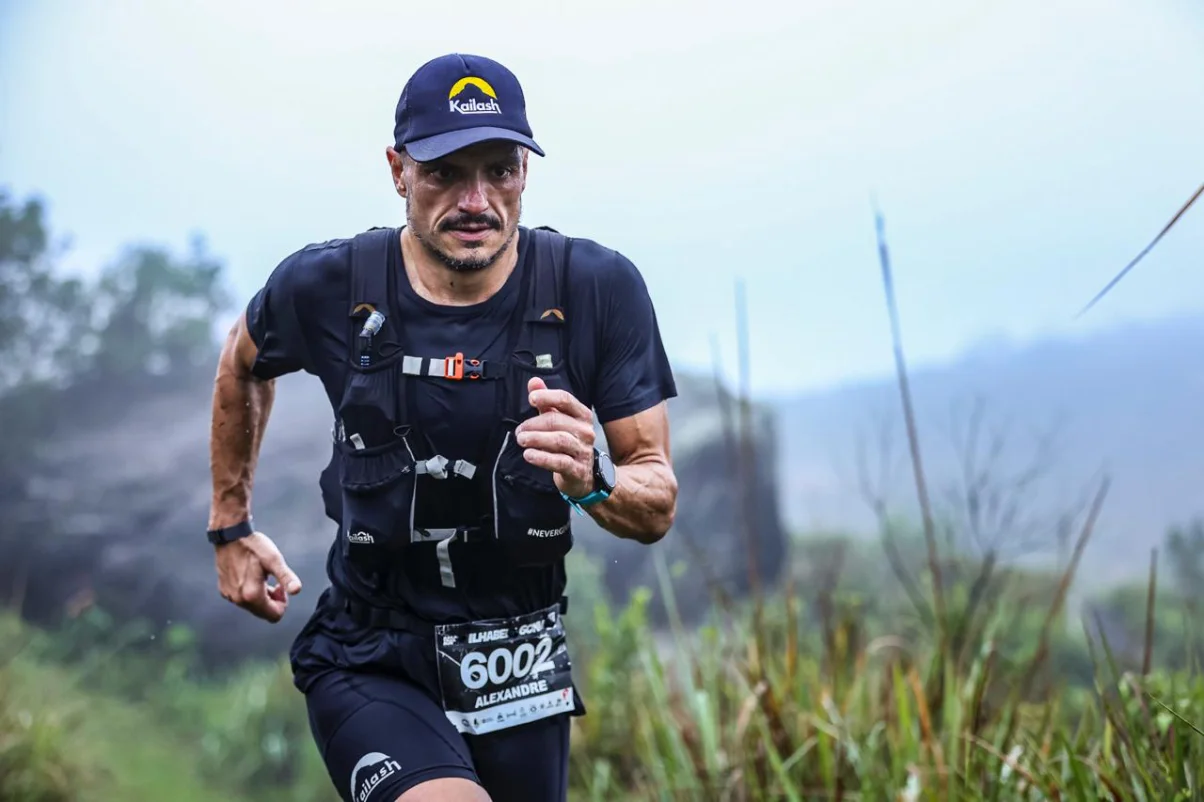
Kailash Fast 10L Backpack Vest – Alexandre Gonçalves
More Lightness in Carrying Gear
In addition to the pockets available in the Deuter Traick 9 Backpack, Rosália and André also highlight the comfort provided by its fabric. “I’ve never seen anything like the mesh on this backpack, which is elastic and breathable. I hadn’t known about this technology, and I absolutely love it,” comments Rosália.
André uses the model for special training sessions on Saturdays. “It’s an extremely comfortable, versatile, and flexible backpack. Despite holding a lot of gear, it doesn’t feel like it has 9 liters of capacity. Plus, the model comes with 8 bungee cords, which make it easier to carry poles and also provide replacements in case any of them break.”

deuter Traick 9 Backpack for Trail Running – André Medeiros
In addition to the Deuter model, Rosália also recommends backpacks from The North Face, praising their similar quality. “The backpacks are slim, lightweight, and have many pockets.”
For Alexandre, the more elastic and compact the backpack, the easier it is to adjust it to the body, providing more comfort and allowing better performance during the run. “The Kailash Fast 10L Backpack Vest is breathable and highly elastic both in the front and on the sides, as well as in the adjustment areas and straps. It is very stable during the run and doesn’t cause discomfort to the body. The backpack should not be an extra burden during the run, especially in long races.”
Practicality for Those Who Use Trail Running Poles
If you use running poles, it is essential that the backpack facilitate their transport and handling, as in many races, the equipment will only be used on specific sections.
André Medeiros emphasizes that pole holders, a kind of fabric sleeve, are very practical. According to the athlete, the backpacks Zephyr Pro Vest and Apex Pro Vest, both from CamelBak, come equipped with this removable pole holder at the back. There’s even a space to roll and store the accessory when not in use. “This provides much more comfort for carrying the poles than belts attached at the waist level.”
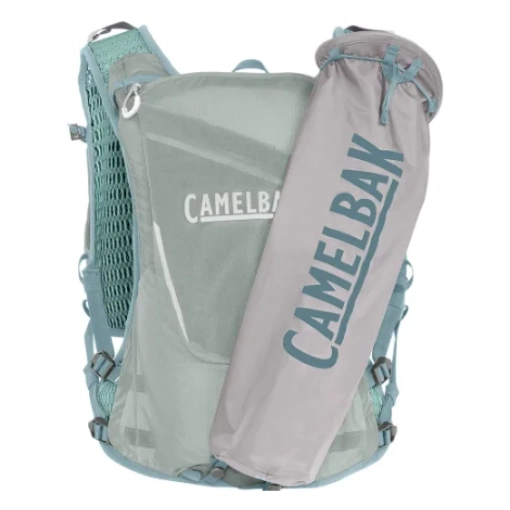
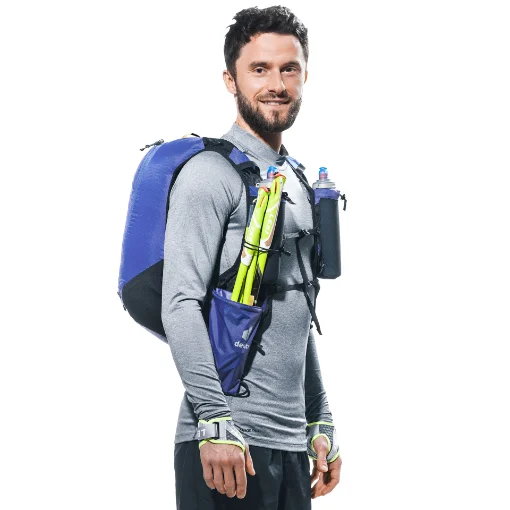

CamelBak Zephyr Pro Vest (1), deuter Ascender 13 (2), and deuter Traick 5 (3)
Meanwhile, Deuter backpacks have different formats for securing and transporting the poles: the Ascender model, for example, has a front pocket that makes access easier, while the Traick model has bungee cords to secure the poles, which can be placed both on the back and the front, on the backpack straps.
In this video, Pedro Lacaz Amaral shows this and other features of the Zephyr Pro Vest:
Other Tips to Ensure Comfort When Using Trail Running Backpacks:
– Carefully Evaluate the Straps: It is important to ensure that the straps won’t hurt your shoulders. “Some models have too much padding on the straps, which ends up causing discomfort. I prefer simpler models,” says Rosália.
André Medeiros explains that when running with a lot of weight, it’s normal for the backpack to bounce a little, stretching the straps, especially if they are very thin. The recommendation is to choose wider straps, which provide more comfort under the load.
– Light Colors for Hot Races: Another recommendation from Rosália is to think about the color of the backpack according to the race you are doing. “It’s important to avoid overheating the body. In the 100-mile race at Western States, in the United States, for example, I used a white backpack from The North Face because it’s a very hot race”. The light-colored backpack was also chosen by the athlete for the 100 miles of the HOKA Kodiak, from UTMB.
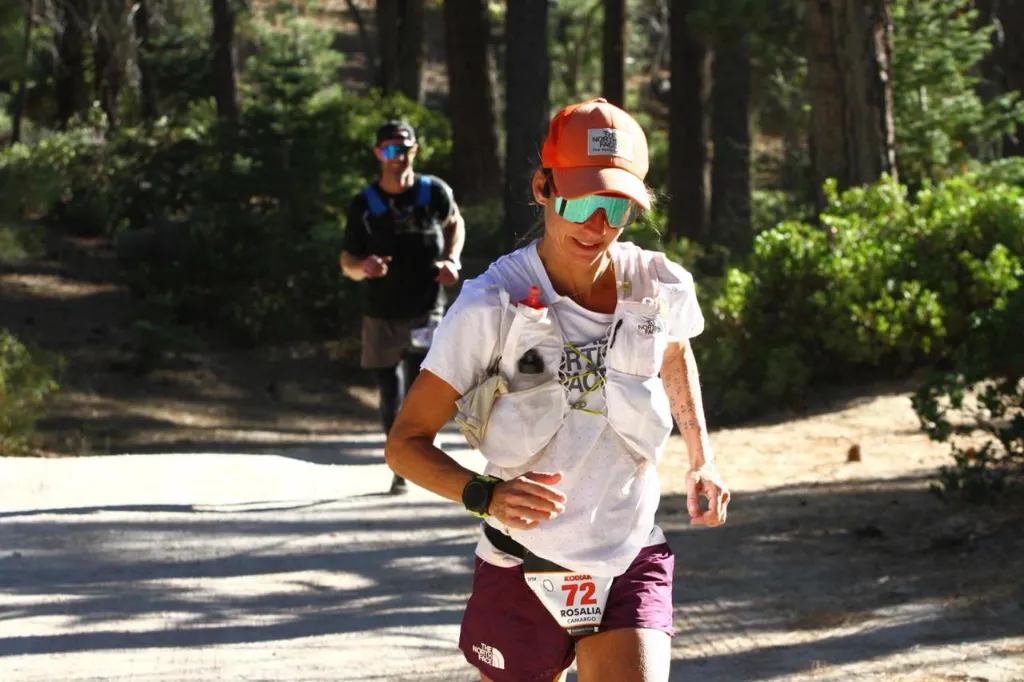
The North Face Vest 8 in use at UMTB Kodiac 100 miles – Rosália Camargo
Good Option for Those Starting in Trail Running
One tip for those starting in trail running is the NTK Trail Run 3L Hydration Backpack for Running, launched by NTK in 2025.
Guilherme Guedes, a runner since 2010, pointed out the main characteristics as high-quality material, wide and comfortable straps, and mesh pockets that hold 500 ml water bottles and snacks well. He also highlights the larger zipper size compared to other brands’ backpacks, which, according to him, makes it easier to handle with sweaty hands.
Guilherme is 1.75 m tall, and the backpack fit well on his body. “I felt very comfortable with the size on my back and under my arms.”

NTK Trail Run 3L Backpack – Guilherme Guedes
If Possible, Use One Backpack for Training and Another for Trail Running Races
Just like trail running shoes, backpacks deteriorate over time. Therefore, athletes recommend reserving one model exclusively for training and another for races.
Rosália explains that she follows this recommendation for two reasons. “The first is psychological. Since I use a backpack every day, I like to run with a different model on race day to feel like it’s a special day. Mentally, for me, that’s important. The second reason is that the backpack used daily experiences wear and tear. Using a newer one exclusively for races helps preserve the material.”
André Medeiros points out that, in addition to the backpack used daily having a shorter lifespan, various components can deteriorate, such as the bungee cords. “Having a newer backpack for races helps avoid surprises.”
One recommendation from athletes is to do some training with the backpack that will be used in the race to adjust it to the body. “Running with the backpack requires different mechanics, and it’s another item you’ll carry on race day,” explains Rosália.
3 Tips for Maintaining Trail Running Backpacks
1. Don’t Wash Backpacks in Washing Machines
Although it may seem more practical, washing backpacks in machines can damage them, wearing out zippers and bungee cords. Wash them by hand with water and soap. A tip is to use your shower time for this!
2. Choose a Shady Spot to Dry the Backpacks
Excessive sun can fade backpacks. Prefer a shady spot. On very hot days, backpacks dry quickly. Leave the pockets open to avoid the elastic materials drying out improperly.
3. Read the Instruction Manual!
For effective care, it is essential to know the product. Read the manuals carefully and follow the brand’s instructions.
We also invite you to watch the video “All About Trail Running Backpacks | CamelBak and Deuter,” which explores in detail the backpacks and hydration systems most suitable for trail running from the brands CamelBak and Deuter.
This post is also available in: Português (Portuguese (Brazil)) Español (Spanish)
